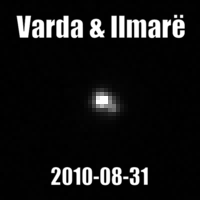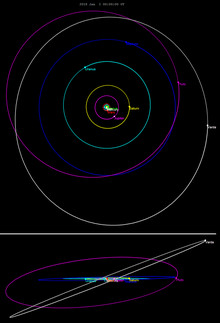ヴァルダ (小惑星)
| ヴァルダ 174567 Varda | |
|---|---|

| |
2010年と2011年にハッブル宇宙望遠鏡によって撮影されたヴァルダとその衛星イルマレ
| |
| 仮符号・別名 | 2003 MW12[1] |
| 小惑星番号 | 174567[1] |
| 見かけの等級 (mv) | 20.5[2] |
| 分類 | 太陽系外縁天体(TNO)[1] キュビワノ族[3] 分離天体[4] |
| 発見 | |
| 発見日 | 2003年6月21日[1][5][6] |
| 発見者 | J. A. Larsen[1][5][6] |
| 発見場所 | キットピーク国立天文台[1][5][6] |
| 軌道要素と性質 元期:2020年5月31日(JD 2459000.5)[1] | |
| 軌道の種類 | 楕円軌道 |
| 軌道長半径 (a) | 46.110 au[1] |
| 近日点距離 (q) | 39.510 au[1] |
| 遠日点距離 (Q) | 52.711 au[1] |
| 離心率 (e) | 0.14315[1] |
| 公転周期 (P) | 313.12 年(114,366 日)[1] |
| 軌道傾斜角 (i) | 21.511°[1] |
| 近点引数 (ω) | 180.072°[1] |
| 昇交点黄経 (Ω) | 184.151°[1] |
| 平均近点角 (M) | 275.208°[1] |
| 次回近日点通過 | ≈ 2096年11月1日[7] ±4 日 |
| 衛星の数 | 1 |
| 物理的性質 | |
| 平均直径 | 740±14 km (面積相当)[8] 722+82 −76 km[注釈 1][9] |
| 質量 | (2.45±0.06)×1020 kg[8][注釈 2] |
| 平均密度 | 1.23±0.04 g/cm3 (自転周期11.82時間)[8] 1.78±0.06 g/cm3 (自転周期5.61時間)[8] |
| 自転周期 | 5.61 h[9]または5.91 h (衛星を考慮しない場合)[10] 11.82 h (衛星を考慮する場合)[10] |
| スペクトル分類 | IR (やや赤)[9] B−V=0.886±0.025[9] V–R=0.55±0.02[11] V−I=1.156±0.029[9] |
| 絶対等級 (H) | 3.81±0.01 (主天体)[8] 3.097±0.060[9] 3.4[1] |
| アルベド(反射能) | 0.099±0.002 (主天体)[8] 0.102+0.024 −0.024[12] |
| ■Template (■ノート ■解説) ■Project | |
ヴァルダ(174567 Varda)とは、太陽系の最も外側の領域に位置する、エッジワース・カイパーベルトのキュビワノ族に分類されている二重小惑星の太陽系外縁天体である[1]。仮符号2003 MW12[1]。その衛星であるイルマレは2009年に発見された[13]。
マイケル・ブラウンは、絶対等級が3.5で、直径が約700–800キロメートル (430–500 mi)であると推定している[14][15]。準惑星である可能性がある[16]。ただし、William M. Grundyらによると、サイズ範囲が400~1000kmで、アルベドが約0.2未満、密度が約≈1.2 g/cm3以下の天体は、分化するどころか完全に固体になることはないだろうと主張しており、準惑星である可能性は非常に低い[17]。ヴァルダの密度が低いのか高密度なのかは明らかではない。
発見と軌道
[編集]
ヴァルダは2006年3月に、United States Naval Academy Trident Scholarプロジェクトの一環としてスペースウォッチ望遠鏡を用いてJeffrey A. Larsenが2003年6月21日付けの画像を使用して発見された[18]。
公転周期は313.1年で、39.5~52.7天文単位離れた距離で太陽の周囲を公転している(114,000日以上、軌道長半径は46.1天文単位)。その軌道は、離心率が0.14で、黄道に対して21.5°傾いている[1]。2019年11月の時点で、ヴァルダは太陽から47.5天文単位離れた位置に存在する[2]。2096年11月頃に近日点に到達するとみられている[7]。23の衝で321回観測されており、1980年までのプレカバリー画像が存在する[1][5]。
名称
[編集]ヴァルダとその衛星の名称は2014年1月16日に発表された。ヴァルダ(クウェンヤ:[ˈvarda])は、J・R・R・トールキンの架空世界、中つ国の神話におけるヴァリエで、星々の女王、星をともす者と呼ばれ、星々を創造し、太陽と月の道を定めた存在である[5]。イルマレはマイエで、ヴァルダの侍女である[5]。
衛星
[編集]ヴァルダには、2009年に発見された衛星のイルマレ(またはヴァルダ I)が存在している。密度とアルベドをヴァルダと同じであると仮定すると、直径は約350km(ヴァルダの約50%)と推定され、全体の質量の8%、つまり2×1019 kgとされている[注釈 2]。
ヴァルダとイルマレの間の距離は4809±39 km(ヴァルダの半径の約12倍)で、イルマレの公転周期は5.75日である。
物理的特性
[編集]見かけの等級と想定されるアルベドに基づいて、ヴァルダとイルマレの推定合計サイズは792+91
−84 kmであり、ヴァルダのサイズは722+82
−76 kmと推定される[9]。この2つの総質量は約2.66×1020 kgである。ヴァルダとイルマレの両方の密度が等しいと仮定すると、密度は約1.24 g/cm3と推定されている[12][9]。一方、イルマレの密度またはアルベドがヴァルダの密度またはアルベドよりも低い場合、ヴァルダの密度は1.31 g/cm3まで高くなる[9]。
2018年9月10日、ヴァルダの予測直径は、恒星の掩蔽により766±6 kmと測定され、予測扁平率は0.066±0.047であった。同等の直径は740kmであり、以前の測定値と一致している[8]。掩蔽に由来するヴァルダの同等の直径を考えると、その幾何アルベドは0.099と測定され、大型の冥王星族である(208996) 2003 AZ84と同じ程度となる。 ヴァルダの自転周期の大きな不確実性は、その密度と真の扁平率についてさまざまな予測値を想定させる。自転周期が5.91時間または11.82時間の場合、そのかさ密度と真の扁平度は、それぞれ1.78±0.06 g/cm3と0.235または1.23 g/cm3と0.080のいずれかになる[8]。
ヴァルダとイルマレの両方の表面は、スペクトルの可視部分と近赤外線部分(スペクトル分類IR)で赤く見え、イルマレはヴァルダよりもわずかに赤くなる。これらのスペクトルは吸水率を示していないが、メタノール氷が存在する証拠を示している。ヴァルダの自転周期は5.61時間と推定されている[9]。
脚注
[編集]脚注
[編集]出典
[編集]- ^ a b c d e f g h i j k l m n o p q r s t u “JPL Small-Body Database Browser: 174567 Varda (2003 MW12)”. ジェット推進研究所 (30 May 2019). 20 February 2020閲覧。
- ^ a b “AstDys (174567) Varda Ephemerides”. Department of Mathematics, University of Pisa, Italy. 2019年11月24日時点のオリジナルよりアーカイブ。2019年11月24日閲覧。
- ^ “MPEC 2009-P26 :Distant Minor Planets (2009 AUG. 17.0 TT)”. Minor Planet Center (2009年8月7日). 2009年8月24日閲覧。
- ^ Marc W. Buie. “Orbit Fit and Astrometric record for 174567”. SwRI (Space Science Department). 2019年11月24日閲覧。
- ^ a b c d e f “174567 Varda (2003 MW12)”. Minor Planet Center. 24 November 2019閲覧。
- ^ a b c “List of Transneptunian Objects”. Minor Planet Center. 5 June 2018閲覧。
- ^ a b JPL Horizons 場所: @sun (近日点は、Deldotが負から正に変化するときに発生する。近日点の時間の不確実性は3シグマである。)
- ^ a b c d e f g h Souami, D.; Braga-Ribas, F.; Sicardy, B.; Morgado, B.; Ortiz, J. L.; Desmars, J. (August 2020). “A multi-chord stellar occultation by the large trans-Neptunian object (174567) Varda”. Astronomy & Astrophysics 643: A125. arXiv:2008.04818. Bibcode: 2020A&A...643A.125S. doi:10.1051/0004-6361/202038526.
- ^ a b c d e f g h i j k Grundy, W. M.; Porter, S. B.; Benecchi, S. D.; Roe, H. G.; Noll, K. S.; Trujillo, C. A. et al. (September 2015). “The mutual orbit, mass, and density of the large transneptunian binary system Varda and Ilmarë”. Icarus 257: 130–138. arXiv:1505.00510. Bibcode: 2015Icar..257..130G. doi:10.1016/j.icarus.2015.04.036.
- ^ a b Thirouin, A.; Noll, K. S.; Ortiz, J. L.; Morales, N. (September 2014). “Rotational properties of the binary and non-binary populations in the trans-Neptunian belt”. Astronomy and Astrophysics 569: 20. arXiv:1407.1214. Bibcode: 2014A&A...569A...3T. doi:10.1051/0004-6361/201423567.
- ^ Tegler, S. C.; Romanishin, R. W.; Consolmalgo, J. S. (December 2016). “Two Color Populations of Kuiper Belt and Centaur Objects and the Smaller Orbital Inclinations of Red Centaur Objects”. The Astronomical Journal 152 (6): 13. Bibcode: 2016AJ....152..210T. doi:10.3847/0004-6256/152/6/210.
- ^ a b Vilenius, E.; Kiss, C.; Mommert, M.; Müller, T.; Santos-Sanz, P.; Pal, A. et al. (May 2012). “"TNOs are Cool": A survey of the trans-Neptunian region. VI. Herschel/PACS observations and thermal modeling of 19 classical Kuiper belt objects”. アストロノミー・アンド・アストロフィジックス 541: 17. arXiv:1204.0697. Bibcode: 2012A&A...541A..94V. doi:10.1051/0004-6361/201118743.
- ^ Johnston, Wm. Robert (31 January 2015). “Asteroids with Satellites Database – (174567) Varda and Ilmare”. Johnston's Archive. 5 June 2018閲覧。
- ^ “(174567) Varda, 2018 September 10 occultation”. asteroidoccultation.com (26 July 2019). 28 November 2019閲覧。
- ^ Braga-Ribas, Felipe; Sicardy, Bruno; Assafin, Marcelo; Ortiz, José-Luis; Camargo, Julio; Desmars, Josselin; et al. (September 2019). The stellar occultation by the TNO (174567) Varda of September 10, 2018: size, shape and atmospheric constraints (PDF). EPSC-DPS Joint Meeting 2019. Vol. 13. European Planetary Science Congress. 2019年10月14日閲覧。
- ^ Brown, Michael E.. “How many dwarf planets are there in the outer solar system?”. カリフォルニア工科大学. 9 February 2018閲覧。
- ^ W.M. Grundy, K.S. Noll, M.W. Buie, S.D. Benecchi, D. Ragozzine & H.G. Roe, 'The Mutual Orbit, Mass, and Density of Transneptunian Binary Gǃkúnǁʼhòmdímà ((229762) 2007 UK126)', Icarus (forthcoming, available online 30 March 2019) Archived 7 April 2019 at the Wayback Machine. DOI: 10.1016/j.icarus.2018.12.037,
- ^ Larsen, Jeffrey A.; Roe, Eric A.; Albert, C. Elise (2007). “The Search for Distant Objects in the Solar System Using Spacewatch”. The Astronomical Journal 133 (4): 1247–1270. Bibcode: 2007AJ....133.1247L. doi:10.1086/511155.
関連項目
[編集]- (55565) 2002 AW197 - 軌道、サイズ、色が似ている太陽系外縁天体。
- 小惑星の一覧 (174001-175000)
外部リンク
[編集]- List of binary asteroids and TNOs, Robert Johnston, johnstonsarchive.net
- LCDB Data for (174567) Varda, Collaborative Asteroid Lightcurve Link
- (174567) 2003 MW12 Precovery Images
- ヴァルダ - JPL Small-Body Database
| 小惑星帯 |
| |||||
|---|---|---|---|---|---|---|
| ケンタウルス族 |
| |||||
| 冥王星族 |
| |||||
| トゥーティノ族 |
| |||||
| キュビワノ族 |
| |||||
| 散乱円盤天体 |
| |||||
| 分離天体 |
| |||||
| セドノイド |
| |||||
| その他 / 未知の共鳴 |
| |||||
Text is available under the CC BY-SA 4.0 license; additional terms may apply.
Images, videos and audio are available under their respective licenses.


